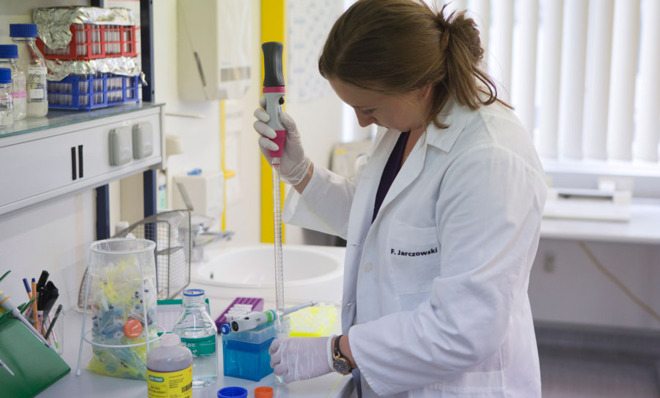How collaborative innovation led to the experimental serum for Ebola
Innovation used to spring from the minds of individuals. But in our hyper-connected world, it now comes from a dynamic kind of groupthink.

Kent Brantly and Nancy Writebol, the two American aid workers infected with the Ebola virus while volunteering in Liberia, were released from the hospital yesterday after they recovered from the illness.
They were both given an experimental serum, Zmapp, before being flown from Liberia to CDC facilities in Atlanta, Georgia, three week ago. Brantly — who was seriously deteriorating before the drug was administered — yesterday appeared overjoyed, telling the media he was "thrilled to be alive."
These two Americans might have recovered anyway. In the West African communities that have been ravaged by Ebola this year, the death rate of between 50 and 60 percent has been markedly lower than the 90 percent rate observed in some previous Ebola outbreaks. And Zmapp — which is derived from antibodies produced by mice that have been infected with Ebola, and has only thus been made in extremely limited quantities — is not a proven therapy for Ebola. No human clinical trials have been carried out to prove its effectiveness or safety, and until proper clinical trials are completed, the main weapon in the battle against Ebola will continue to be containment.
The Week
Escape your echo chamber. Get the facts behind the news, plus analysis from multiple perspectives.

Sign up for The Week's Free Newsletters
From our morning news briefing to a weekly Good News Newsletter, get the best of The Week delivered directly to your inbox.
From our morning news briefing to a weekly Good News Newsletter, get the best of The Week delivered directly to your inbox.
But beyond the recovery of Brantly and Writebol, there are some hopeful signs that Zmapp might be the real deal. In animal trials, four Ebola-infected monkeys that received Zmapp within 24 hours of infection survived. Half of another group of four monkeys that were treated within 48 hours survived. And three Liberian doctors who received the last available doses of Zmapp are reportedly recovering from the illness, according to the Liberian health ministry.
Ebola — which emerged in the 1970s and is thought to be hosted by fruit bats — is a particularly menacing illness, not only because it has a very high mortality rate, but until now has proven untreatable. Viruses in general are hard to treat for a variety of reasons. They are rapidly evolving, meaning that our immune systems struggle to hunt them down and eradicate them. They are much smaller than bacteria and other germs, and unlike bacteria live and replicate inside our cells, offering them a layer of protection from medicines and the immune system. Their small size — and low number of genes — means that scientists struggle to find medicines that can effectively attack them. They also invade cells in parts of the body that the immune system struggles to reach, such as nerve cells. And because viruses do not have metabolic functions to disrupt, antibiotics are ineffective.
Furthermore, Ebola has mostly infected communities in the developing world, meaning pharmaceutical companies have little financial incentive to really invest in curing it. While the U.S. government invested $42 million toward Ebola research in 2013, this pales in comparison to the huge sums pharmaceutical companies commit to treating other less deadly — but more marketable — ailments. The International Society for Hair Restoration Surgery estimates $2 billion is spent internationally per year on research and treatments for male pattern baldness. Yearly funding to treat erectile dysfunction tops $1 billion worldwide, according to 2011 research by Harvard Medical School.
Zmapp was born out of a collaboration between biotech firms Mapp Biopharmaceutical, LeafBio, and Dreyfus Inc., as well as the U.S. government and the Public Health Agency of Canada. This kind of collaborative problem-solving has become increasingly common in science and technology.
A free daily email with the biggest news stories of the day – and the best features from TheWeek.com
As former Federal Reserve Chairman Ben Bernanke noted last year:
Invention was once the province of the isolated scientist or tinkerer. The transmission of new ideas and the adaptation of the best new insights to commercial uses were slow and erratic. But all of that is changing radically. We live on a planet that is becoming richer and more populous, and in which not only the most advanced economies but also large emerging market nations like China and India increasingly see their economic futures as tied to technological innovation... Moreover, because of the Internet and other advances in communications, collaboration and the exchange of ideas take place at high speed and with little regard for geographic distance... In short, both humanity’s capacity to innovate and the incentives to innovate are greater today than at any other time in history. [Business Insider]
Thanks to these new systems, we are finally beginning to see progress made on catastrophic illnesses like Ebola. And even if Zmapp turns out not to be the miracle cure that the world hopes it is, the collaborative technological infrastructure that produced Zmapp is already in place to find something better.
John Aziz is the economics and business correspondent at TheWeek.com. He is also an associate editor at Pieria.co.uk. Previously his work has appeared on Business Insider, Zero Hedge, and Noahpinion.


